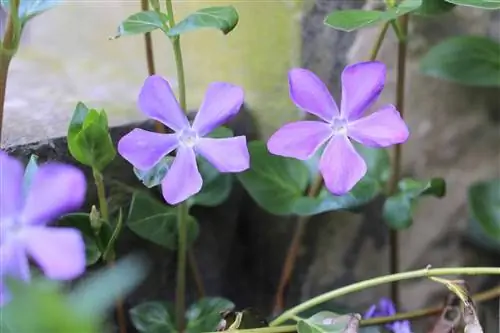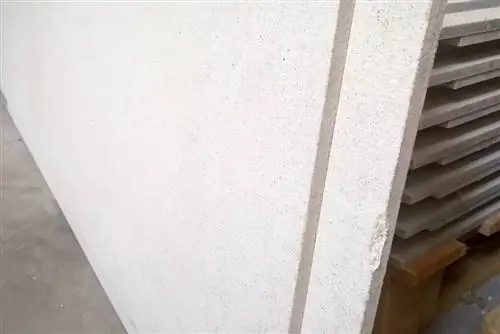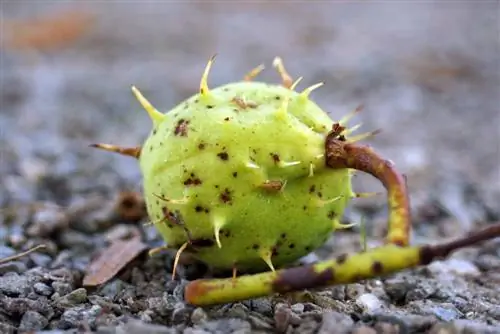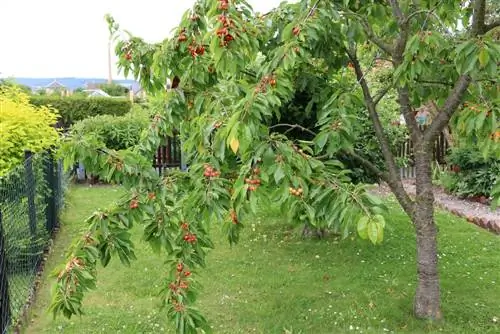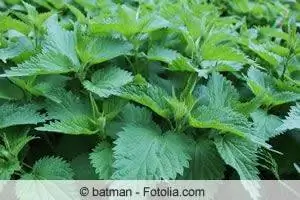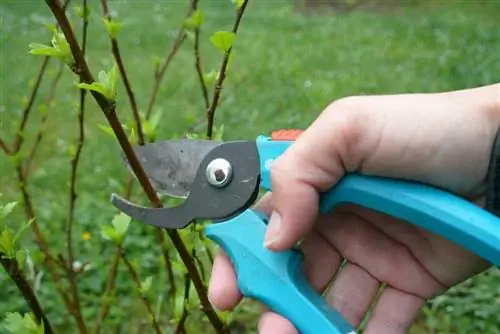- Author admin [email protected].
- Public 2023-12-17 03:39.
- Last modified 2025-01-24 12:45.
The large evergreen (bot.: Vinca Major) is a subshrub that is rarely found in the wild. The main distribution areas of the evergreen shrub include the western and central Mediterranean and parts of Asia Minor. Despite the relatively warm climate that usually prevails in the countries of origin of the large evergreen, the incredibly decorative subshrub is hardy. In fact, most varieties of the large periwinkle, which incidentally belongs to the dogpoison family (Apocynaceae), can even survive icy temperatures of up to -15 °C without damage. Nevertheless, it is advisable to take special precautions in harsh locations in order to get the large evergreen safely through the winter.
Location
The large evergreen prefers soil that is rich in humus and consistently moist. In the case of “lean” soil, it is therefore advisable to amend it with potting soil and/or mature compost before planting. In addition, the location should be sunny to partially shaded. Purely green varieties can even be planted directly in the shade. It is worth mentioning that Vinca Major tolerates root pressure surprisingly well, so that it can even be planted under trees, shrubs and bushes without any problems. Varieties with colorful foliage, on the other hand, can quickly develop a malformation of their leaf pattern in excessively shady locations. However, it is also important to avoid excessive light, especially since Vinca Major is generally very sensitive to winter sun.
Plants
Since the large evergreen spreads rapidly, the individual plants should be planted at a minimum distance of 35 to 40 cm from each other. As a result, only five to a maximum of seven plants can be planted per square meter, no matter how delicate the young seedlings may appear. In addition, there should be no other plants in the immediate vicinity that could fall victim to the Vinca Major's urge to spread. It is also advisable to thoroughly clear the bed of weeds, especially since subsequent weeding is difficult given the dense growth of the large evergreen. It is also advisable to rake up the surrounding ground a little so that the side shoots can root more easily and the plant itself is better supplied with rain or irrigation water.
When digging the planting hole, make sure that it is approximately twice as wide as the roots. Depending on the nature of the soil, it may be advisable to add some mature compost mixed with ordinary garden soil in a ratio of 1/3 into the hole until it is about 3/4 full. The still loose soil should then be watered well until it becomes muddy. Only now does the large evergreen come into the planting hole. The hole is then completely filled with soil, which should then be tamped down a bit. The ideal time for planting is spring, although the large evergreen can also be planted in late summer or early autumn if necessary. However, planting in midsummer is strictly not recommended.
Summary
- Removing weeds from the bed
- raking the bed
- Dig planting holes
- Fill planting holes 3/4 full with loose soil (add compost if necessary)
- Water the soil
- Insert periwinkle
- Fill the hole with soil
- Press soil firmly to finish
Care
If a suitable location with good soil quality has been chosen, the large evergreen turns out to be much easier to care for than is generally assumed. In fact, care is limited to annual pruning in spring and watering as needed. With regard to the pruning, it should be mentioned that it is primarily used for shaping. It also prevents the Vinca Major from spreading too much. In addition, targeted thinning of the plant can be an effective remedy against the development of various plant diseases and fungal infestation. However, it should be noted in this context that only clean tools may be used for cutting plants, otherwise unwanted disease transmission from other plants could occur. Apart from that, the scissors used should be as sharp as possible so that the shoots to be cut are not bruised too much.
Incidentally, the best time to cut back is shortly before the budding phase, which can start as early as the beginning of February, depending on the weather. There is hardly any reason to worry about cutting off too much of the evergreen, which is resistant to cutting and grows back quickly. The only important thing is that the remaining shoots have enough leaves. There should also be some nodes left over from which new roots can grow.
Propagation
The propagation of the large evergreen turns out to be very easy. All that is required are short pieces of shoots with at least one pair of leaves, which usually only have to be pierced from their cut surface into the moist soil in order to be able to grow new roots. Alternatively, side shoots with nodes that have already formed tender roots can of course also be used. In both cases, it is advisable to take cuttings from he althy plants with good growth.
Tip:
If you want to propagate your large periwinkle, you can leave a few side shoots standing when pruning in spring until their nodes form roots.
Wintering
In areas with relatively mild winters where the minimum temperatures are usually well above -15 °C, you can usually leave the large periwinkle outdoors throughout the cold season without any concerns. Depending on the location, it may be advisable to provide additional protection from the winter sun. However, if a particularly harsh winter is to be expected, at least some plants should be moved to a safe place to protect them from excessive cold. It is recommended to place the plants in a sufficiently large flower pot with fresh potting soil.
However, you must make sure that the winter quarters are neither too bright nor too warm, otherwise the large evergreen threatens to sprout too early or, in the worst case, could even be damaged. In addition, periwinkle should not be watered too often in winter. Note: If you have to cut back your large evergreen before repotting, you can only cut off as much as is absolutely necessary due to the outstanding spring pruning.
Frequently asked questions
What could be causing my large periwinkle to get leaf spots?
Although there are various possible causes, in most cases it is due to the leaves getting too much sunlight.
Can I use the ripe seeds of my Vinca Major for sowing?
Of course you can sow the seeds. However, your large periwinkle can be propagated much easier and, above all, much faster using cuttings.
What you should know about the large periwinkle in brief
- Species/Family: Subshrub, belongs to the Apocynaceae family
- Care effort: low, easy to care for, robust, undemanding is at least the original form (see flowers below)
- Flowering period: April to May with star-shaped blue, purple or white flowers (see flowers below) on short shoots
- Foliage: Evergreen, elongated, ovoid, small and leathery leaves in shiny dark green
- Growth: Ground cover, fast-growing woody subshrub, spreads through long rooted tendrils lying on the ground, strong spread through runners
- Height: 20 to 30 cm
- Location: sunny to shady, cool, with a place with strong morning sun being ideal (see also location below), humus and loose soil that should be dry rather than too moist
- Planting time: any time as long as the ground is not frozen
- Pruning: tolerates severe pruning in spring to avoid spreading too much, but not necessary
- Partners: Astilbe, Christmas rose, fern, foxglove, shade grasses, forest goat's beard
- Propagation: Division from spring to summer, the plants root at the lying leaf nodes, so that rooted or unrooted cuttings can be cut here at any time (as long as the ground is not frozen)
- Care: water during long dry periods, fertilization is not necessary if fallen leaves are left lying around (they are processed into humus by soil organisms)
- Wintering: the original form is quite hardy, the varieties usually need winter protection, if you are unsure, simply covering with some sticks is enough
- Illnesses/problems: hardly any problems if the location is right
Special features
- is native from the Mediterranean to the Caucasus
- Can cope with even the deepest shade under trees
- all parts of the plant are poisonous
- can also be cultivated in hanging baskets
Art
Small periwinkle (Vinca minor): height 10-15 cm; otherwise identical to the large periwinkle, just less susceptible
Varieties
- ‘Bowles’: blooms in a dark purple
- 'Gertrude Jeckyll': White and very floriferous variety when established and given good winter protection
- 'Reticulata': delights with its yellow-green center as an extraordinary leaf pattern
- 'Rubra': stands out with its purple flowers
- 'Variegata': quickly catches the eye with its yellowish-white foliage

